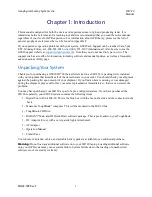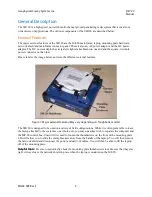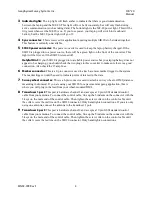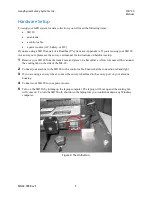
Geophysical Survey Systems, Inc.
SIR® 20
Manual
MN92-078 Rev F
10
•
We need to have a Source and an Output folder because the SIR 20 will store different parts of
your data in different places. It does this so that parts of data that you don’t want to get
overwritten by accident (like project info files) are protected in the Source folder while the
system stores other files in the Output (like collected and processed data).
5
Appearance:
Set your viewing preferences under Appearance.
•
This tab controls the look and feel of the software. If you like to see Large Buttons on the screen
for example, make sure that that choice is checked. These changes will take effect the next time
that SIR 20/RADAN is started.
6
Linear Units:
This sets your units of measurement and the order of magnitude of those
measurements. Choose whatever you feel is appropriate for your application.
7
SIRVEYOR:
If you are using a GPS with your system, click the SIRVEYOR tab to configure the
GPS. Instructions on this can be found in the GPS integration chapter.
8
Click OK once you are satisfied that you have set up the system to your desired parameters.
Setting Up your System for 2D Data Collection
Projects and Profiles: How the SIR 20 Collects Data
The SIR 20 collects data files by using a Project file as a model. The project file is created when you enter
collection parameters. Each time you tell the SIR 20 to collect a new data file, it will examine the
parameters you provided in the project file and collect data with those settings. Let’s first look at the three
main file types that are important in 2D data collection: Project, Data, and Macro files. As you create
these different file types, try to keep a notebook with their names and your job information. That way,
you will know what all of these file types mean when you go to review your work. All of these files will
be stored in the folder that you created in the previous section.
Project Files
have the extension *
.rpj
. Their function is to serve as a list of instructions to the SIR 20 so
that the system knows how to collect your data files and what to name them. The name of each data file is
taken from the name of your project file. For example, if you call you project file Test.rpj, you data files
will be named Test001, Test002, etc. You should keep your project file names as short as possible (less
than 8 characters). RADAN will only use the first eight characters of your project file name for each data
(*.dzt) file name. This can lead to confusion if your project file names are too long.
Data Files
have the extension *
.dzt
. These are your actual radar data profiles. When you open a data file
in RADAN, you are opening a *.dzt file. The data file takes it name and data acquisition parameters from
the project file. These files contain a File Header as well. The file header contains all of the acquisition
parameters settings used to collect a specific *.dzt file
Macro Files
have the extension *
.
cmf
. These files contain specific settings that your system needs for
collection. You create the macro file during the project file setup process and the macro file is then
attached to the project file. The SIR 20 will use your project file and your macro file as a list of
instructions to collect your data files. This information is stored in the File Header.
Содержание SIR 20
Страница 1: ......
Страница 4: ......
Страница 6: ......
Страница 12: ...Geophysical Survey Systems Inc SIR 20 Manual MN92 078 Rev F 6 ...
Страница 56: ...Geophysical Survey Systems Inc SIR 20 Manual MN92 078 Rev F 50 ...
Страница 67: ...Geophysical Survey Systems Inc SIR 20 Manual MN92 078 Rev F 61 Figure 65 Migration Comparisons ...
Страница 88: ...Geophysical Survey Systems Inc SIR 20 Manual MN92 078 Rev F 82 ...
Страница 96: ...Geophysical Survey Systems Inc SIR 20 Manual MN92 078 Rev F 90 ...






























